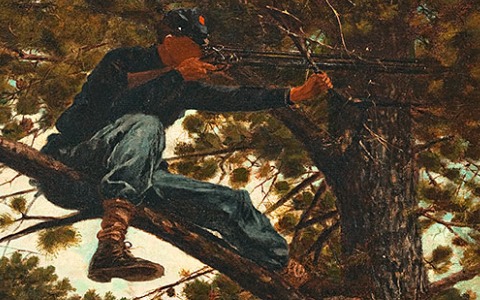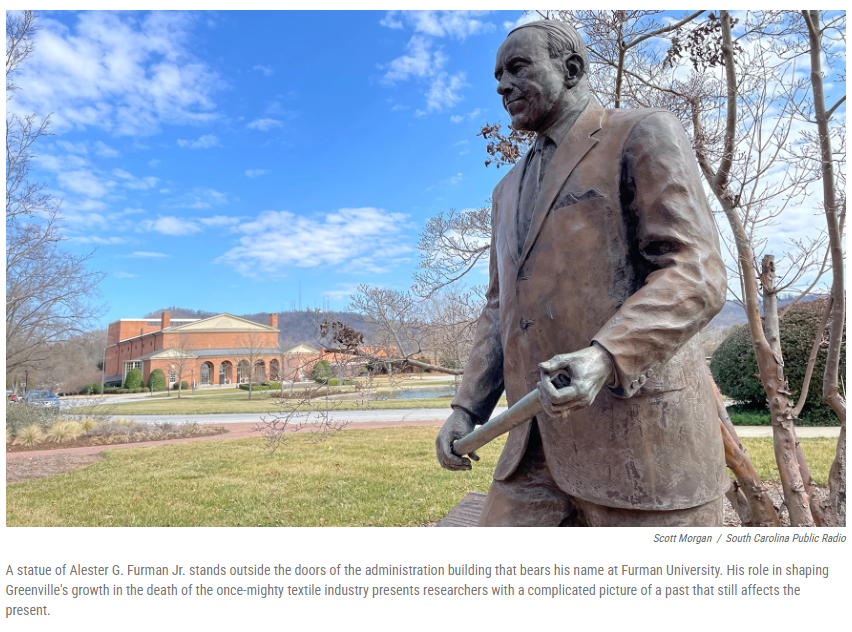More Americans were killed in the American Civil War than in all the other wars of the 20th century put together. The late great art critic, Robert Hughes, waxed poetic about its impact on American art in his sweeping 1997 work, American Visions. “It swallowed up the men of blue and gray as a furnace swallows coal. It was America’s Illiad, and America’s holocaust.” The effects of the Civil War were felt at every level of life in American culture, especially in its art. It changed the entire landscape of the country physically and psychologically, and its wounds are still palpable even today.
Every great exhibition usually brings a great exhibition catalogue with it, and The Civil War and American Art is a glorious companion piece to the Metropolitan Museum of Art’s moving, beautifully curated, perspective-altering show. It’s a big, thick book with over 300 pages of lush, sensuous color reproductions of American masterworks by Frederic Church, Sanford Robinson Gifford, Winslow Homer, Eastman Johnson, as well as work by the pioneering photographers, Matthew Brady, Alexander Gardner, and Timothy O’Sullivan.
The book’s author, Eleanor Jones Harvey is the curator of the recent exhibition The Civil War and American Art at the Smithsonian American Art Museum in Washington, D.C. (16 November 2012 – 28 April 2013). Harvey has laid out a series of carefully crafted chapters about painting and photography, from the 1850s to the 1870s, these crucial 20years before, during, and after the war, that build in momentum and intensity to give the reader a sense of not only the key images of the period, but the ideas that ran through those images.
The show, and consequently, the book, focuses primarily on genre and landscape paintings and war and landscape photography during the war years. There’s no mention or inclusion of any sculpture of this period, notably Augustus Saint-Gaudens’s Memorial to Robert Gould Shaw and the Massachusetts Fifty-Fourth Regiment (1884) in Boston and his golden memorial to William Tecumseh Sherman in New York’s Central Park (1892), both pivotal works and epoch-defining in their own way. Thus, Harvey’s definition of “art” in her title refers only to painting and photography. However, for the parameters of this show, that’s a fair omission. Consolidating the vast array of material from this period and distilling a key argument to a representative set of artworks must have been a daunting challenge that Harvey accomplished with great flair and intelligence.
The scope of paintings includes works by more artists from the North rather than the South, but some memorable Confederate canvases stand out. Notably, Everett B.D. Fabrino Julio’s The Last Meeting of Lee and Jackson (1869), a Grand Manner history painting of the two generals in deep conversation, a painting shrouded in such cloying reverence and self-aggrandizement that Mark Twain said it looked as if Jackson had a declined Lee’s dinner invitation and was asking him for a match. Memorable, too, are Conrad Wise Chapman’s Fort Sumter paintings of 1863, tattered and ennobled Confederate flags flying against the coastal winds through cannon fire.
But it’s really the work of the northern artists that stay with you. One of Harvey’s areas of expertise is American 19th century landscape painting, and the best chapter in the book in terms of its intelligence and craftsmanship is “Landscapes and the Metaphorical War”. Harvey’s argument is that even though many of the painters did not paint the war directly, it was always on their minds and came through in their canvases, either allegorically or more literally.
The leading painter of the Hudson River School, Frederic Church, is the star of this section. Church’s stunning swirl of fiery reds and smoke of a volcanic eruption in South America in 1862,Cotopaxi, was painted the year after Frederick Douglass made his famous speech declaring slavery to be “a moral volcano”. More direct in its intentions is Church’s 1861 painting Our Banner in the Sky, the setting sun and emerging night stars of the sky coalescing physically and spiritually into the Stars and Stripes. The Union cause as God’s cause.
The chapter, “The Art of Wartime Photography”, is also very strong. We have to remember that this was the first American war to be witnessed by the modern art and technology of photography and its documentary impact was radical. It’s hard to fantasize about the romance of war when you’re confronted with the image of bloated, rotting corpses strewn across a battlefield.
A talented firebrand Scotsman named Alexander Gardner joined Matthew Brady’s photography studio in New York in 1857, and went on assignment with him during the war. Gardner had an uncanny eye for the gruesome and the poetic. His 1862 photographs of the aftermath of Antietam, Union and Confederate dead splayed along the lonely fields, are mesmerizing. Crowds lined up from out the door of Brady’s studio when these photographs were shown for the first time.
Stunning also, and unforgettable, is Timothy O’Sullivan’s A Harvest of Death, Gettysburg, July 1863-bodies strewn along the field the morning after Lee’s retreat stretching out into the distant horizon. The image of lives being lost and sown like grain occurs again in a painting by the other heavily represented artist in this show, Winslow Homer. The Veteran in a New Field (1865), of a man in overalls reaping a thicket of golden wheat, would have resonated with its audience. Not a single family was unmoved by the scale of the War, and this image of the reaper is hauntingly ambiguous—one of both tragedy and hope.
Homer was commissioned by the leading periodical of the day, Harper’s Weekly, to go to the front lines of General George McClellan’s army to sketch and paint first-hand accounts of war. Homer went far beyond the confines of a mere illustrator to give us the most haunting and enduring images o f the Civil War. His Sharpshooter of 1863, a lean, soulful young killer, curled up in a shadowy elm tree with a shotgun poised at his target, is perhaps one of the most haunting images of the Civil War captured as a single cursory image.
I was a little sad not to see Homer’s extraordinary, hypnotic painting of c. 1864 in the show, In Front of Yorktown—a mysterious, ineffably beautiful and sad image of a young man staring into a smoldering campfire flame the night before the siege of Yorktown, Virginia in 1862. The Homers that Harvey includes are outstanding, no doubt, but this one is special in its enduring melancholy and beauty. That solitary flame, according to the art historian Alexander Nemerov, is something akin to the eternal warmth and mystery of life itself.
Ultimately, Harvey’s book is perfect for lovers of American art and history. It has an absorbing, engrossing power of its own akin to the power of what Ken Burns’s The Civil War had for the television audience of the ‘90s. It gives us a profound sense of what the Civil War really was like, how people felt and reacted to it, and its enduring impact on American life. If you have the chance, go see the exhibition at the Smithsonian in D.C. or at the Met in New York this summer. But do get a hold of this extraordinary book, too.
Farisa Khalid is a writer living in New York. In addition to PopMatters, her work appears on Asia Society’s Asia Blog. She graduated from Vassar College and has a Masters in Public Health from Emory University and an MA in Art History from New York University. Follow her on twitter @FarisaKhalid





